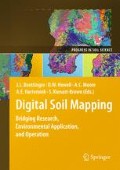Abstract
We sought to predict soil classes by applying random forests (RF), a decision tree analysis, to predict 24 soil classes across an arid watershed of western Utah. Environmental covariates were derived from Landsat 7 Enhanced Thematic Mapper Plus (ETM+) and digital elevation models (DEM). Random forests are similar to classification and regression trees (CART). However, RF is doubly random. Many (e.g., 500) weak trees are grown (trained) independently because each tree is trained with a new randomly selected bootstrap sample, and a random subset of variables is used to split each node. To train and validate the RF trees, 561 soil descriptions were made in the field. An additional 111 points were added by case-based reasoning using photo interpretation. As RF makes classification decisions from the mode of many independently grown trees, model uncertainty can be derived. Furthermore, the probability that a pixel belongs to one or more classes in the legend can be determined. The overall out of the bag (OOB) error for discrete classes was 55.2%. The confusion matrix revealed that four soils that frequently co-occurred on landforms were frequently misclassified as each other. These soils were combined into six soil map units. To identify pixels that might belong to one of these newly created combinations of soil classes, minimum threshold probabilities were set. Employing probability by class can be an effective and objective method of determining membership in soil map unit associations and complexes mapped at the 1:24,000 scale.
Access this chapter
Tax calculation will be finalised at checkout
Purchases are for personal use only
Preview
Unable to display preview. Download preview PDF.
References
Bailey, T.C., and Gatrell, A.C., 1995. Interactive Spatial Data Analysis. Prentice Hall, Harlow England.
Breiman, L., 2001. Random forests. Machine Learning 45:5–32.
Breiman, L., and Cutler, A., 2009. Random forests homepage. http://www.stat.berkeley.edu/breiman/RandomForests/cc_home.htm (last verified 14 April 2010).
Chavez, P.S., Jr., 1996. Image-based atmospheric corrections – revisited and improved. Photogrammetric Engineering & Remote Sensing 62:1025–1036.
Chen, C., Liaw, A., and Breiman, L., 2004. Using random forests to learn unbalanced data. Technical Report 666, Statistics Department, University of California at Berkeley. [Online] Available: http://www.stat.berkeley.edu/tech-reports/666.pdf (last verified 14 April 2010).
ESRI GIS and Mapping Software, 2007. ArcGIS 9.2. ESRI, Redlands, CA.
Gislason, P.O., Benediktsson, J.A., and Sveinsson, J.R., 2006. Random forests for land cover classification. Pattern Recognition Letters 27:294–300.
Gesch, D.B., 2007. Chapter 4 – The national elevation dataset, pp. 99–119. In: Maune, D.F. (ed.), Digital Elevation Model Technologies and Applications: The DEM Users Manual, 2nd ed., American Society for Photogrammetry and Remote Sensing, Bethesda, MD.
Jenny, H., 1941. Factors of Soil Formation. McGraw-Hill, New York, NY.
Leica Geosystems, 2006. ERDAS Imagine V. 9.1. Leica Geosystems, Atlanta, GA
McBratney, A.B., Mendonça Santos, M.L., and Minasny, B., 2003. On digital soil mapping. Geoderma 117:3–52.
Moran, C.J., and Bui, E.N., 2002. Spatial data mining for enhancing soil map modeling. International Journal of Geographical Information Science 16(6):533–549.
Nield, S.J., Boettinger, J.L., and Ramsey, R.D., 2007. Digitally mapping gypsic and natric soil areas using Landsat ETM data. Soil Science Society of America Journal 71:245–252.
RSGIS, 2003. Remote Sensing and Geographic Information Systems Laboratory, Utah State University, http://earth.gis.usu.edu/imagestd/ (last verified 13 August 2009).
Salford Systems, 2004. Random Forests V. 1.0. Salford Systems, San Diego, CA.
Shi, X., Zhu, X-A., Burt, J.E., Qi, F., and Simonson, D., 2004. A case-based reasoning approach to fuzzy mapping. Soil Science Society of America Journal 68:885–894.
Soil Survey Staff, 2006. Keys to Soil Taxonomy, 10th ed., U.S. Department of Agriculture, Natural Resources Conservation Service, Washington, DC, pp. 26–28. [Online] Available: http://www.soils.usda.gov/technical/classification/tax_keys (last verified 14 April 2010).
U.S. Department of Agriculture, Natural Resources Conservation Service, 2007. National Soil Survey Handbook, title 430-VI sec. 627.03.d. [Online] Available: http://www.soils.usda.gov/technical/handbook/contents/part627.html#03 (last verified 14 April 2010).
Utah GIS Portal, 2009. National Elevation Dataset available for Utah, http://gis.utah.gov/elevation-terrain-data/national-elevation-dataset-ned (last verified 13 August 2009).
Author information
Authors and Affiliations
Corresponding author
Editor information
Editors and Affiliations
Rights and permissions
Copyright information
© 2010 Springer Science+Business Media B.V.
About this chapter
Cite this chapter
Stum, A., Boettinger, J., White, M., Ramsey, R. (2010). Random Forests Applied as a Soil Spatial Predictive Model in Arid Utah. In: Boettinger, J.L., Howell, D.W., Moore, A.C., Hartemink, A.E., Kienast-Brown, S. (eds) Digital Soil Mapping. Progress in Soil Science, vol 2. Springer, Dordrecht. https://doi.org/10.1007/978-90-481-8863-5_15
Download citation
DOI: https://doi.org/10.1007/978-90-481-8863-5_15
Publisher Name: Springer, Dordrecht
Print ISBN: 978-90-481-8862-8
Online ISBN: 978-90-481-8863-5
eBook Packages: Earth and Environmental ScienceEarth and Environmental Science (R0)

